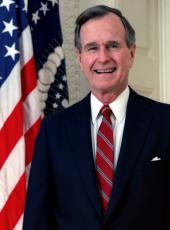A Proclamation
Long before European explorers set foot on the North American continent, this great land has been cultivated and cherished by generations of American Indians. Unbeknownst to their fellowman halfway around the world, these Native people has developed rich, thriving cultures, as well as their own systems of social order. They also possessed a wealth of acquired wisdom and skills in hunting, tracking, and farming -- knowledge and skills that would one day prove to be invaluable to traders and settlers from Europe.
Today Americans of all ages recognize the many outstanding achievements of this country's original inhabitants and their descendants. Young and old alike know the story of Sacajawea, the Shoshone woman who helped to guide Lewis and Clark on their historic expedition and, in so doing, helped to open the door to the Great West. The giant redwood trees protected in a number of our national parks bear the name of Sequoia, in honor of the great Cherokee leader who taught thousands of Indians to read and write and, in so doing, helped to unite and strengthen the Cherokee Nation. We also recall the achievements of Charles Curtis, the proud descendant of Native Americans who served this country not only as a member of Congress but also as Vice President. However, such celebrated examples constitute only a small portion of the rich, centuries-old heritage of American Indians. Indeed, each of the many tribes that have inhabited this great land boasts a long and fascinating legacy of its own.
Last year, when signing into law the "National Museum of the American Indian Act," I noted that our Nation would be moving forward with a new and deeper understanding of the diverse heritage of Native Americans. Like the many educational and cultural events currently being held across the country in observance of National American Indian Heritage Month, the development of a national museum dedicated to the preservation of American Indian history, art, language, literature, anthropology, and culture will help to enhance public awareness of -- and appreciation for -- these proud peoples.
During the National American Indian Heritage Month, as we celebrate the fascinating history and time-honored traditions of Native Americans, we also look to the future. Our Constitution affirms a special relationship between the Federal Government and Indian tribes and -- despite a number of conflicts, inequities, and changes over the years -- our unique government-to-government relationship has endured. In recent years, we have strengthened and renewed this relationship. Today we reaffirm our support for increased Indian control over tribal government affairs, and we look forward to still greater economic independence and self-sufficiency for Native Americans.
The Congress, by Public Law 101-343, has designated November 1990 as "National American Indian Heritage Month" and has authorized and requested the President to issue a proclamation in observance of this month.
Now, Therefore, I, George Bush, President of the United States of America, do hereby proclaim November 1990 as National American Indian Heritage Month. I encourage all Americans and their elected representatives at the Federal, State, and local levels to observe this month with appropriate programs, ceremonies, and activities.
In Witness Whereof, I have hereunto set my hand this fourteenth day of November, in the year of our Lord nineteen hundred and ninety, and of the Independence of the United States of America the two hundred and fifteenth.

GEORGE BUSH
George Bush, Proclamation 6230—National American Indian Heritage Month, 1990 Online by Gerhard Peters and John T. Woolley, The American Presidency Project https://www.presidency.ucsb.edu/node/268413

